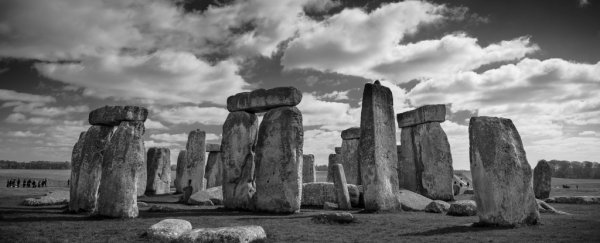Researchers have finally identified the quarries where the bluestones that make up Stonehenge were originally mined – and they've revealed that the rocks were extracted 225 km away in Wales around 500 years before the English monument was constructed, leading them to believe that an early version of the Neolithic monument might have been built in Wales, before being taken apart and put back togther in Wiltshire, England where it now stands.
It's long been known that some of the smaller rocks that make up Stonehenge – known as bluestones – came from Wales, but researchers couldn't figure out exactly where they were mined. Now a team of UK archaeologists and geologists has identified a series of holes in rocky outcrops that perfectly match the shape, structure, and size of Stonehenge's bluestones.
Bluestone is the name given to any foreign stones at Stonehenge, and the most common of these are composed of spotted dolerite and rhyolite, which geologists have already identified as coming from the Preseli Hills in Wales. But what's been confusing is the fact that Stonehenge is also made up of large sandstone rocks known as 'sarsen', which were mined nearby in England. So why would the creators have gone to such an effort to ship in the bluestones as well?
This is why it's so exciting that researchers have now identified the outcrops where the bluestones originated, called Carn Goedog and Craig Rhos-y-felin. Not only did the stones match the recesses in these locations, but the team also found similar rocks at the sites that were left behind by the builders, and a 'loading dock' where the stones could have been dragged away.
But what's really interesting is when these sites were in use. The team radiocarbon-dated burnt hazelnuts and charcoal left over from the workers' camp fires, and revealed that the stones were mined long before they were used to build Stonehenge – which is located around 225 km from the quarries.
"We have dates of around 3400 BC for Craig Rhos-y-felin and 3200 BC for Carn Goedog, which is intriguing because the bluestones didn't get put up at Stonehenge until around 2900 BC," said lead researcher Parker Pearson from University College London.
"It could have taken those Neolithic stone-draggers nearly 500 years to get them to Stonehenge, but that's pretty improbable in my view," he added. "It's more likely that the stones were first used in a local monument, somewhere near the quarries, that was then dismantled and dragged off to Wiltshire."
The discovery, which has been published in the journal Antiquity, also provides some valuable clues as to how the bluestones made their way to Stonehenge, and how they were mined.
"They only had to insert wooden wedges into the cracks between the pillars and then let the Welsh rain do the rest by swelling the wood to ease each pillar off the rock face," explains one of the researchers, Josh Pollard, from the University of Southampton. "The quarry-workers then lowered the thin pillars onto platforms of earth and stone, a sort of 'loading bay' from where the huge stones could be dragged away along trackways leading out of each quarry."
And although previous writers have suggested that the stones were taken southwards from the hills to Milford Haven and then floated towards Wiltshire on boats or rafts, the new discovery suggests that this was unlikely.
"The only logical direction for the bluestones to go was to the north then either by sea around St David's Head or eastwards overland through the valleys along the route that is now the A40," said Pearson. "Personally I think that the overland route is more likely."
Each of the stones was estimated to weigh less than 2 tonnes, and so could have been moved by people or oxen using rail-like timber.
The team will continue to excavate the quarry sites in 2016, with the hope of discovering the original monument – and they think they may have nearly narrowed down the location, which is in between the two quarries.
"Stonehenge was a Welsh monument from its very beginning," said Pearson. "If we can find the original monument in Wales from which it was built, we will finally be able to solve the mystery of why Stonehenge was built and why some of its stones were brought so far."
